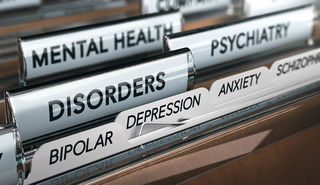Psychiatry
The Push to Rethink Psychiatric Diagnosis
A major new initiative to change how we approach and treat mental distress.
Posted February 13, 2020 Reviewed by Lybi Ma

When former NIMH director Thomas Insel conceded in May 2017 that the $20 billion spent on research during his tenure had failed to “move the needle” for patients and caregivers, he opened the door to long-delayed reforms that for the most part have stalled in the years since.
“I spent 13 years at NIMH really pushing on the neuroscience and genetics of mental disorders,” Insel said at the time, “and when I look back on that I realize that while I think I succeeded at getting lots of really cool papers published by cool scientists at fairly large costs—I think $20 billion—I don’t think we moved the needle in reducing suicide, reducing hospitalizations, improving recovery for the tens of millions of people who have mental illness. I hold myself accountable for that.”
The frank admission might have encouraged a greatly reduced emphasis on biomarkers and “precision medicine for psychiatry,” ending the decades-long dominance of biological psychiatry so that underfunded but proven and effective approaches in social medicine, cognitive therapy, and psychotherapy could benefit from greater funding and attention.
But $20 billion is a lot to write off when the alternative is “lots of really cool papers published by cool scientists.” And, despite his regrets, Insel has since doubled-down on his tech-based approach to psychiatry, trading the Google-based company Verily for a start-up that focuses on “digital phenotypes,” with all their associated risks and assumptions. In short, the allure of biomarkers has continued more or less undimmed, even as evidence of their accuracy is wanting, and patients and taxpayers are left wondering what other treatments the $20 billion might have funded.
The episode is worth relaying because, despite all the hand-wringing over imbalances within “bio-psycho-social” approaches to mental distress, a brain-based approach continues to dominate American and European psychiatry, relegating the “psychical” and “social” to neglected afterthoughts. Since the 1980s, both DSM and ICD systems have represented distress as a “disorder,” suggesting a condition both innate and lifelong, even though earlier editions of the DSM had no problem calling them “reactions,” including to social and environmental stressors, and difficult life events.
When a disorder is characterized as biological, the default solution is pharmacological. Slick and expensive marketing campaigns exploit that advantage, to publicize first the condition (to build “disease-awareness”), then the represented remedy. What is treated, clinics and university research centers continue to insist, despite the widespread debunking of the notion, is a “chemical imbalance” or “serotonin deficiency.” The drugs prescribed are in fact psychotropics with a long and concerning record of adverse effects, including from drug-related withdrawal.
As part of an effort to end this stalemate and “pluralize” both medicine and approaches to mental distress, an international group of mental health professionals is demanding a new look at psychiatric diagnosis itself. In an open letter published yesterday and endorsed by leading international mental health organizations, the Task Force of the American Psychological Association’s Division 32: Society for Humanistic Psychology is leading an initiative to introduce “significant changes to our diagnostic systems to combat the continued and continuous medicalization of our natural and normal emotional responses.”
“One in five Americans now takes a psychiatric drug,” the Task Force notes in its open letter to leaders of the American Psychiatric Association and World Health Organization, “with widespread problems of dependence, and therefore physical and psychological harm.” As “prescription follows diagnosis,” U.N. Special Rapporteur Dr. Dainius Pūras is quoted as explaining, so “the excessive use of diagnostic categories [can] lead to excessive medicalization.”
The effort to rethink psychiatric diagnoses and their consequences draws heavily on The Standards and Guidelines for the Development of Diagnostic Nomenclatures and Alternatives in Mental Health Research and Practice, a set of aspirational proposals developed in August 2014 at the Global Summit on Diagnostic Alternatives in Washington, DC. A joint initiative of the APA’s Division 32 and the British Psychological Society’s Division of Clinical Psychology, The Standards and Guidelines were published in 2018. According to those formulating them, they were designed
to serve as a guiding resource and reference for the development of scientifically sound and ethically principled diagnostic nomenclatures and descriptive alternatives. They are also intended to guide the development of new models that are theoretically coherent, readily applicable, and relevant to the theoretical and practical dilemmas facing researchers and practitioners in psychiatry, clinical psychology, social work, and other mental health disciplines.
“Coherent, applicable, and relevant”: Neither the DSM nor the ICD can assure such outcomes, critics as different as Insel and the APA’s Division 32 contend, because in both cases the question of validity and scientific reliability is not solved. “Over time,” notes Task Force Co-Chair Sarah R. Kamens and colleagues of the recent history of psychiatric taxonomies, “the discovery of empirical anomalies, including high rates of comorbidity and phenotypic overlap (i.e., fuzzy boundaries) between presumably discrete diagnostic categories, led to mounting uncertainty about the reliability and validity of the neo-Kraepelinian model” adopted by both DSM and ICD. “Gradually, it became clear that diagnostic categories as defined by the DSM are not only phenotypically but also genotypically heterogeneous, such that multiple biogenetic and neurological correlates are shared across disorder categories.”
Far from leading to “an evidence-based diagnostic taxonomy that [could] ‘cut nature at its joints,’” as the architects of both diagnostic manuals hoped, the comorbidity, imprecise criteria, and low diagnostic thresholds encouraged significant overprescribing and, over the years, the medicalization of ordinary conditions (shyness, loneliness, grief, and many more).
As does the Task Force for APA’s Division 32, The Standards and Guidelines highlight the systemic damage caused by widespread conflicts of interest within academic psychiatry, particularly over industry-funded research and the nonpublication of negative results. They focus on the necessary involvement of persons with lived experience (“experts by experience”), as well as on the importance of considering “both traditional alternatives to the current diagnostic system [and] alternatives to diagnosis as such.”
“Biomedical psychiatry does not have a monopoly of understanding,” notes Peter Kinderman, Professor of Clinical Psychology at the University of Liverpool and former President of the British Psychological Society, of the effort to rethink diagnosis and treatment. “Seeing our difficult emotions as symptoms of mental illness is only one way of thinking about them, with advantages and disadvantages.”
The initiative is commendable and deserves widespread support on both sides of the Atlantic. A wholesale rebalancing of psychiatric diagnosis and treatment is long overdue. The open letter to leaders of the American Psychiatric Association and World Health Organization appears here.
References
Kamens S. R., L. Cosgrove, S. M. Peters, et al (2018). “Standards and Guidelines for the Development of Diagnostic Nomenclatures and Alternatives in Mental Health Research and Practice.” J. Humanistic Psychology 59.3: 401-27. [Link]
Kinderman P., S. Kamens, B. D. Robbins, and F. Farley (2.12.2020). “Regarding the reform and revision of diagnostic systems: An open letter from Div. 32 (Society for Humanistic Psychology) and the British Psychological Association.” [Link]




